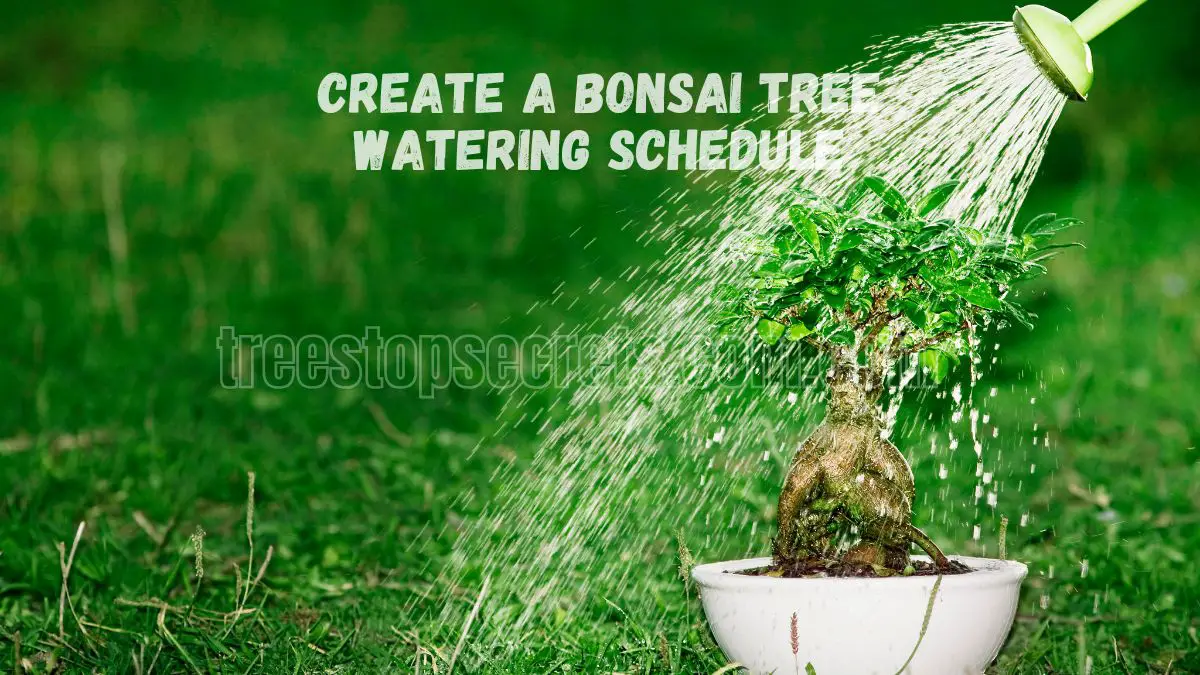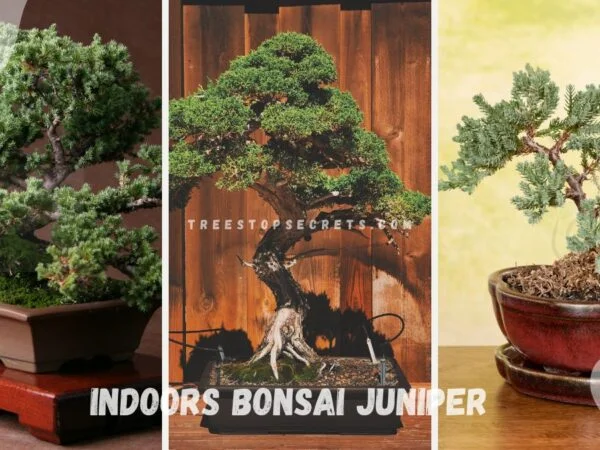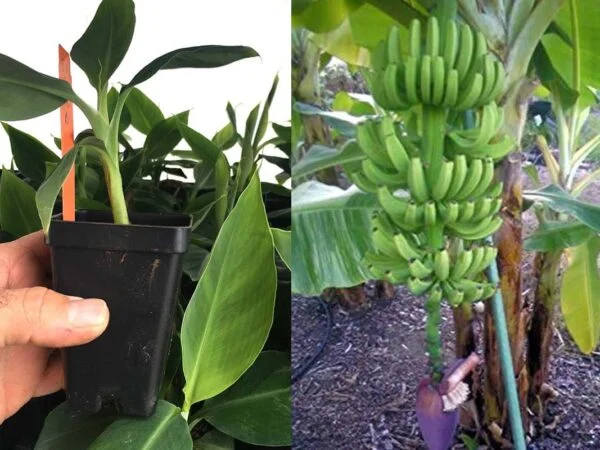Providing the right bonsai tree watering schedule is key to ensuring your miniature tree lives a long and healthy life. Getting a bonsai watering schedule down will help ensure your tree puts down strong roots and stays with you for many more years to come.
Typically, bonsai trees need watering every few days, but factors like the type of tree, pot size, and climate can change that. After watering, make sure you water thoroughly so it drains out the bottom. This will help all of your roots stay nice and hydrated.
Gradually your trees will let you know when it’s time to water again with consistent observations of the soil moisture. Read on for advice on developing the best watering routine for your trees. This simple routine will ensure that your bonsai thrives and stays beautiful and healthy.
Key Takeaways
- Pay attention to things like temperature, humidity, sunlight and wind as these all can help you determine the right bonsai watering schedule. These factors can all affect how much water your tree needs, so it’s important to be mindful of them.
- Modify your watering schedule based on the species of your bonsai. From succulents to tropicals, every plant has specific needs for moisture. Knowing what your bonsai needs will help you steer clear of the classic blunders of over-watering or under-watering.
- Look for other signs of bonsai dehydration as well, including wilting foliage and cracked, dry soil. By building your observational skills, you’ll be sure to respond quickly and keep your tree healthy.
- Experiment with alternative watering methods, like soaking techniques or moisture sensing technology. With these tools, you can feel confident that your bonsai is getting the ideal amount of water, setting the stage for a vibrant root system.
- Winter Under watering can lead to root rot, but over watering your bonsai tree is equally dangerous. Monitoring temperature and humidity changes will allow you to adjust your bonsai care as the seasons change and you learn what works best.
- Don’t get caught unprepared while you’re away on vacation! Look into automated systems or trusted caretakers to ensure your bonsai stays watered during your travels.
Understanding Environmental Influences
The environmental influences are the biggest factor in determining how often you’ll need to water your bonsai trees. By understanding these elements, you can develop a watering routine tailored to your bonsai plant's needs, ensuring they stay healthy and vibrant.
1. How Temperature Affects Watering Needs
Temperature is a huge factor in determining how much water your bonsai should get. As it gets hotter, your bonsai will require more water, so you’ll need to be monitoring the soil even more often.
Contrary to the advice most of us may have heard, during a heat wave you want to water daily. The pleasant weather means you can water once every few days instead. Understanding these shifts allows you to ensure your bonsai is hydrated properly.
2. The Role of Humidity in Water Requirements
Humidity is yet another major factor. In hot and dry environments, your bonsai will dry out more quickly and require more frequent watering.
On the flip side, in arid or especially dry climates, you might end up irrigating more frequently. Humidity trays are an easy way to keep enough moisture in the air.
Keep in mind that not all species will respond the same way to humidity, so observe your bonsai and see how it reacts to changes.
3. Impact of Sunlight on Soil Moisture
Sunlight has an impact on soil moisture. Direct sunlight dries out your soil faster, meaning you might have to water more frequently.
If your bonsai is kept in full sun, you might try taking it into a shadier area during the hottest months. Monitoring soil moisture throughout the day will give you a better picture of the soil’s moisture requirements.
4. Wind's Effect on Water Evaporation
Wind can speed the rate at which moisture evaporates from soil. If it’s really windy out, you might need to water more than usual.
By shielding your bonsai from wind, you reduce moisture loss as well.
5. Container Size and Its Influence on Watering
Finally, pot size can be crucial to your success. For example, smaller pots dry out more quickly, necessitating more frequent watering than larger pots.
Trial and error with various sizes will help you find the best fit for your bonsai tree.
Bonsai Species and Their Watering Needs
Mastering the watering needs of each bonsai tree species will ensure a healthy, happy bonsai plant that thrives in your care. Every bonsai tree needs to be looked at individually, taking into account their environment and the conditions around them at all times. By knowing exactly what species your bonsai is, you’ll be able to provide the right care and tips to help it flourish.
1. Specific Watering Schedules for Juniper Bonsai
Juniper bonsai trees require a drier climate than most other species. Determine a watering schedule. Water your bonsai plants on a regular schedule, about once a week or every 7-10 days during their growing season.
Keep in mind to modify this frequency as seasons change. In winter, for example, you might only need to water every 2 weeks. When in doubt, check soil moisture often, inserting your fingertip an inch deep into the soil.
If it is dry at that depth, then it is time to water again. Too much water will cause root rot so it’s better to be conservative.
2. Differences in Watering Among Common Species
Now look at some of the most popular bonsai species such as Ficus, Maple and Pine. For example, Ficus species should be watered every 3 to 5 days. Maples are happy to get watered more often and deeply while they are growing.
A simple table can help visualize these needs:
|
Species |
Watering Frequency |
|---|---|
|
Ficus |
Every 3-5 days |
|
Maple |
Every 2-4 days |
|
Pine |
Every 5-7 days |
3. Adapting Care for Tropical vs. Temperate Bonsai
Tropical bonsai, such as Ficus, like their soil consistently moist, whereas temperate species, such as Pines, like to dry out. Plan your itinerary around these likes and dislikes.
Key differences include:
- Tropical: Water more frequently, especially in warmer months.
- Temperate: Allow soil to dry between watering.
Staying in tune with the environmental conditions will allow you to better hydrate your indoor and outdoor types.
Recognizing Watering Needs
Recognizing when your bonsai tree needs watering is crucial for maintaining its health and happiness. By understanding its specific watering needs, you’ll nurture a robust bonsai plant that flourishes under your care. Tuning into these signals will deepen your understanding of bonsai gardening, enhancing your skills as you embark on this rewarding bonsai tree journey.
1. Signs Indicating Your Bonsai Needs Water
Begin with a soil moisture test. When the first inch is dry, it’s a cue to water. Wilting leaves are yet another obvious sign. They’ll droop when your bonsai is in need of water.
Monitor leaf color. Leaves that are starting to yellow are a classic sign that your tree needs water. Similarly, cracks or fissures in the soil surface are another indication that your bonsai is thirsty and needs watering.
2. Identifying Overwatering Symptoms
It’s just as crucial, though, to know the signs of overwatering your bonsai. One manifestation of overwatering, root rot, will cause leaves to yellow and drop.
Check soil moisture consistently to avoid over-watering. If you notice standing water in the container, start watering less often. Avoiding both underwatering and overwatering is important to your tree’s health and survival.
3. Recognizing Underwatering Indicators
Underwatering comes with its own challenges as well. Watch for wilting or drooping leaves, which are typical indicators.
Moisture in the rootball is essential. Dry soil, drying of the moisture available in the rootball, can create all types of stressors to your Bonsai.
Check the tree’s physical condition periodically to identify any symptoms of stress as soon as possible. Following a regular watering regimen to prevent these problems is easy to do.
Techniques for Effective Watering
Learning the best way to water your bonsai trees will not only help them grow but also ensure they live long! Proper watering techniques not only keep your bonsai plant hydrated but also support a robust root system, which is essential for overall growth. Here are some tips to get the most out of your watering.
Best Practices for Watering Bonsai Trees
Ideally, watering will take place in the early morning or late afternoon. This timing helps prevent evaporation from the hot sun and allows moisture to soak into the soil.
Going with a gentle spray nozzle avoids soil washout, leaving the complex root network of your new seedling intact. Instead, try to moisten the entire root ball down to the bottom, so all of the soil is moistened.
Don’t water directly on the leaves. Getting your snow peas wet on the foliage can cause leaf burn and other complications.
Soaking Techniques for Root Health
Soaking is another great technique to encourage healthy roots. To start with, submerge your bonsai pot in a tub of water.
Let it soak until you see no more air bubbles floating to the surface. This technique helps the roots take in moisture at a greater depth, producing more robust growth.
Besides aiming for the right saturation depth, it’s important to regularly track how long you soak to avoid over-saturating your tree, as this can lead to root rot.
Using Moisture Meters for Accurate Assessment
Investing in a moisture meter can help ensure you’re watering with precision. This simple tool will give you an accurate measure of your soil moisture levels, so you can decide when (and when not!) to water.
Continue monitoring the readings and use this feedback to inform your watering practices and keep your plants as hydrated as possible.
Adjusting Watering Routines Seasonally
Watering your bonsai shouldn’t be a guesswork endeavor. As the seasons change, so too must your methods of ensuring America’s oldest living commemoration continues to flourish. Spring, summer, fall, and winter all provide distinct growth cycles and weather conditions that will affect your bonsai’s watering needs.
Getting to know these changes will help you keep your bonsai looking happy and healthy all year long.
1. Modifying Schedules for Different Seasons
Once you get into the growing season during spring and summer, develop a practice of watering every 2-3 days. In late fall or winter, your tree will begin to go dormant. Cut down the watering routine to once a week, or even every other week.
Monitor conditions on site. As a general rule, during extreme heat you may need to increase your watering schedule. Understanding these seasonal patterns is key to watering less and causing less stress on your plants.
2. Climate Considerations in Watering Frequency
Local climate hugely influences when and how often you need to water. For example, if you live in an area with a lot of humidity, your bonsai will need less water than someone who lives in a drier climate.
In addition to total water application, extreme temperatures can impact frequency of watering. By observing weather patterns you can start to predict when your bonsai will require different care, ensuring it remains healthy and happy under your care.
3. Preparing for Seasonal Changes in Care
Once again, planning ahead is key to happy bonsai. Establish a seasonal watering checklist—get ready for the end of summer and fall—so you make the necessary changes to your watering routine.
By being vigilant about bonsai’s reaction to these modifications, you’ll ensure that your bonsai remains happy and healthy.
Common Mistakes in Bonsai Watering
Though bonsai tree watering is a seemingly simple task, it’s one that many bonsai growers get wrong. Familiarizing yourself with some of these common bonsai watering mistakes will help you get the most out of your bonsai plant. Here are some tips to avoid mistakes, so your trees can flourish!
1. Avoiding Over-Reliance on Friends for Care
Overall, planning how you will take care of your bonsai is key. If you need to leave your bonsai in someone else's hands, educate them on the specific needs of your tree.
Give specific directions about how often to water, how much water it needs, and when is the ideal time to water. Keeping in touch while you’re gone is key to keeping your bonsai healthy and happy.
2. Not Soaking the Rootball Properly
It’s really important that you fully soak the rootball to promote a healthy root growth. Make sure that you water thoroughly so that you see water coming from the bottom of the pot.
Be careful with the soak length to avoid waterlogging as this will rot the roots. Change the way you water to promote moisture even throughout the entire root ball.
3. Misjudging Soil Type and Its Impact
Understanding what kind of soil you’re using goes a long way in determining your watering schedule. Different soil compositions hold water in unique ways.
As an example, a soil mix that is heavier with clay will retain soil longer than one heavy in sandy mix. Change your watering routine to match, and feel free to try different soil combinations to help soak in or retain water better.
Strategies for Vacation Care
Just because you take a break doesn’t mean you should forget about your bonsai plant’s health. With some forethought and deliberate directions, vacation care might be just what your small bonsai needs to flourish while you’re gone. Protecting your bonsai trees with the appropriate level of care is key.
1. Planning Ahead for Time Away
Begin by planning a watering session the day you are due to leave. This method is a great way to make sure your bonsai isn’t over or under-hydrated. Think about installing an easy irrigation system for your plants.
Or better yet, enlist the aid of a friend to monitor things while you’re gone on your journey. Before you leave, test the soil moisture. This simple step incorporates a bit of mindfulness in helping you determine how much moisture your bonsai requires.
Whatever shifts a bonsai might experience in its regular care routine, preparing it for that change is important, as it will help make the transition smoother.
2. Automated Systems for Consistent Care
Watering efficiently may require a smart investment in an automated system. These systems can offer consistent hydration customized to your bonsai’s individual needs. Explore Vacations, or a similar site to research various options to discover one that fits your needs best.
By setting timers, you’ll be able to maintain a regular watering schedule, which will help your tree stay healthy even when you’re on vacation. Be sure that you have a way to track the system’s success so you can tweak it down the line as necessary.
3. Finding Reliable Caregivers
Selecting capable and reliable caretakers for your bonsai is a very important step in your trip. Give them clear directions on how to care for the plants, particularly how to water them.
When you return, inspect your bonsai to determine how well the temporary caregiver was able to care for your beloved plants. Cultivating a community of bonsai enthusiasts can help provide care and guidance while you’re away.
Conclusion
Mastering the art of bonsai care requires you to understand when and how to go about watering your miniature masterpiece. Every species is different and understanding those needs will ensure your bonsai lives a healthy, happy life. You can easily avert it with a couple of basic techniques, including checking soil moisture and modifying your watering schedule with the seasons. By skipping common pitfalls, you can keep your bonsai healthy and beautiful for years to come.
Develop a robust watering plan to care for your tree in your absence. By taking the time to consider these factors, you ensure that your bonsai will have everything it needs to flourish. Welcome to the fulfilling world of bonsai tree care! Your miniature wild tree will thrive under your loving care and attention. Begin your bonsai adventure today and experience the tranquility and wonder it offers.
Frequently Asked Questions
How often should I water my bonsai tree?
How often you should water your bonsai trees depends on the species and environment. As a rule, water when the first inch of bonsai soil is dry to the touch. This may be every day in the heat of summer or every 3 to 7 days in winter.
What factors influence bonsai watering needs?
Environmental factors such as temperature, humidity, and light exposure play a huge role in how often your bonsai trees will need watering. Indoor bonsai plants tend to require sufficient water due to dry indoor air, while outdoor bonsai trees need less.
How can I tell if my bonsai needs water?
To ensure proper care of your bonsai trees, verify soil dryness by inserting your finger one inch deep. When the top few inches of bonsai soil feel dry, it is time to water, as yellowing leaves may indicate improper watering.
What techniques should I use for watering?
To apply a like precision, switch to a watering can with a narrow spout for your bonsai trees. Water thoroughly, ensuring the bonsai soil is evenly wet until it drains out the bottom, keeping the leaves dry to minimize fungal diseases.
Should I adjust my watering schedule seasonally?
As the seasons change, you’ll want to adjust your bonsai tree watering needs. In summer, water more frequently since the heat can dry out the bonsai soil quickly. During winter months, cut back on watering, as most bonsai plants require less moisture during their dormant period.
What are common mistakes in bonsai watering?
Thus, overwatering and underwatering both make this list of bonsai tree care mistakes. Regularly checking the soil moisture level is crucial for understanding your bonsai tree watering needs; this way, you can maintain the right balance for your bonsai plant to thrive.
How can I care for my bonsai while on vacation?
You can try a self-watering system for your bonsai trees, or have someone come and water them, Friend style. If you will be gone for a long time, cluster your bonsai plants together in a shady spot to help maintain humidity.
Image Source: Paid image from CANVA





